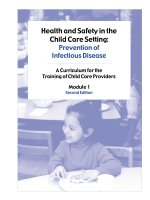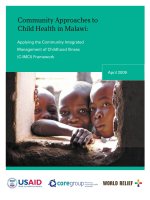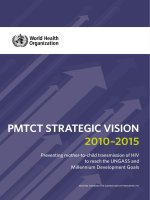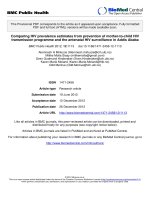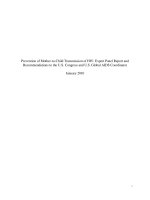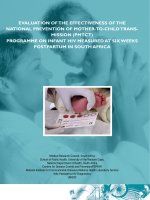Prevention of Mother to Child Transmission of HIV: 2012 pdf
Bạn đang xem bản rút gọn của tài liệu. Xem và tải ngay bản đầy đủ của tài liệu tại đây (1.86 MB, 37 trang )
Prevention of Mother
to Child Transmission
of HIV: 2012
Karen Tulloch, BSc(Pharm), ACPR, PharmD
Disclosure
! No declarations
Learning Objectives
! To understand the mechanism of mother to child
transmission (MTCT) of HIV
! To understand the key points of intervention to prevent
MTCT of HIV
! To be aware of the antiretroviral drug therapy (ART)
recommendations for women in pregnancy (antepartum,
intrapartum) to prevent MTCT-HIV
! To be aware of the ART recommendations for infant
management to prevent MTCT-HIV
Scenarios:
3 women presenting in labour at 37 wks gestation
• 36 yr old female, known HIV infection, receiving
combination ART since 15 wks gestation, viral load
<40 copies/mL
• 36 yr old female, known HIV infection, receiving cART
since 15 wks gestation but incompletely adherent to
therapy, viral load 2,500 copies/mL
• 36 yr old female, unknown HIV status, no prenatal
care, no known medications, IVDU throughout
pregnancy
Mother to Child Transmission of HIV:
Timing & mechanisms of transmission
HIV infected
woman passes
virus onto baby
In utero
infection
At time of
labor and
delivery
Breast-
feeding
Fowler et al. Clin Perinatol 2010;37(4):721-37.
Prevention of MTCT-HIV
! Canadian Perinatal Data
! 2692 mother infant pairs identified in prospective
cohort
! Rate of vertical transmission
! 1990-1996: 20.2%
! 1997-2010: 2.9%
! antenatal ART > 4 wk prior to delivery: 1.6%
! maternal HAART > 4 wk prior to delivery: 0.4%
Prevention of MTCT-HIV
Canadian Perinatal HIV Surveillance Data
2692 mother infant pairs identified in prospective cohort
If initiated > 4 wks prior to delivery: 0.4%
Forbes JC et al. AIDS 2012;26(6):757-63.
!"#$%"&'(&)*%+&%,-%.//0123.3
YEAR ETHNICITY
PRE-CONCEPTION /
ANTENATAL HIV TEST
LEVEL of
OB CARE
IVDU in
PREGNANCY
1 2008 caucasian Positive test – no care poor yes
2 2006 aboriginal Pre-conception – negative intermittent no
3 2001 aboriginal No test poor yes
4 2001 Black Antenatal - negative regular no
5 2000 caucasian Antenatal - negative regular no
6 1998 south asian No test regular no
7 1998 south asian Antenatal – negative regular no
8 1997 aboriginal Antenatal - negative regular yes
Principles to Prevent MTCT-HIV
! Prevent acquisition of HIV
! Prevent unintended pregnancies
! Diagnose infection during pregnancy
! HIV testing part of routine care
1
! Repeat testing if ongoing risk
1
! Prevent HIV transmission to infant
! Maternal care:
antenatal + intrapartum
! Infant care:
pre/post exposure prophylaxis + prevent ongoing
exposure (breastfeeding)
WHO PMTCT Strategic Vision 2010. Accessed Mar 6, 2012
DHHS NIH Perinatal guidelines 2011. Accessed Mar 6, 2012
1
Keenan-Lindsay et al. J Soc Obstet Gynaecol Can 2006; 185:1103-7.
Timing of MTCT with Breastfeeding & No
Antiretroviral Prophylaxis
0% 20% 40% 60% 80% 100%
Early Antenatal
(<36 wks)
Late Antenatal
(36 wks to labor)
Labor and Delivery
Late Postpartum
(6-24 months)
Early Postpartum
(0-6 months)
Proportion of infections
Antepartum Care
! Combination antiretroviral therapy (cART) to ALL women
regardless of CD4 count / viral load
! Timing of initiation depends on CD4 count
! < 350: ASAP even in first trimester
! 350-500: consider starting ASAP even in first trimester
! > 500: after first trimester
! Begin by 28 weeks at the latest through delivery!
DHHS NIH Perinatal guidelines 2011. Accessed Mar 6, 2012
Antenatal cART
(2 NRTI + 1 PI or 1 NNRTI)
NRTI NNRTI PI
Zidovudine
Nevirapine
CD4<250
Atazanavir
Lamivudine
Efavirinz
avoid1-tri
Lopinavir
Abacavir
HLA*B5701-
ve
Etravirine
Ritonavir
Tenofovir
bone?
Rilpivirine
Nelfinavir
Emtricitabine
Darunavir
Didanosine
Fosamprenavir
Stavudine
Saquinavir
Tipranavir
Indinavir
Entry Inhibitor
Maraviroc
Enfuvirtide
Combinations
Combivir
(ZDV-3TC)
Kivexa
Truvada
Kaletra
(LPV/r)
Atripla
avoid1-tri
Complera
Integrase
inhibitor
Raltegravir
Antepartum cART
! Decrease maternal viral load (blood, genital)
! Target < 1,000 copies/mL
! Ideal undetectable < 40 copies/mL
Viral Load (copies/mL) Transmission rate (%)
> 100,000 63%
1
< 1,000 (not on ART) 9.8% (95% CI 7.0-13.4%)
2
< 1,000 (on ART) 1% (95% CI 0.4%-1.9%)
2
1
Garcia PM et al. New Engl J Med 1999;341:394-402.
2
Ioannadis JP et al. JID 2001;183(4):539-45.
Intrapartum Care:
Mode of Delivery
! Known HIV infection:
! Assess recent viral load (known or projected)
! Determine mode of delivery
Vaginal Elective* Caesarian (38wks)
On ART
and
VL <1000 copies/mL
Not on ART
or
VL >1000 copies/mL
*Before the onset of labour
*Prior to rupture of membranes
Legardy-Williams et al. Clin Perinatol 2010;37(4):777-85.
Intrapartum Care:
Intrapartum ART
! Continue antenatal ART
! Initiate IV Zidovudine:
PACTG 076 Landmark trial
• MC, R, DB, PC trial
• Pregnant women (14-34 wks), CD4>200, formula feeding
• ZDV (antenatal 100 mg PO 5/day + Intrapartum 2mg/kg IV load + 1mg/kg infusion
+ infant 2 mg/kg PO Q6H x 6wks) vs. Placebo
• Transmission: ARR 17.2% (8.3 vs. 25.5%) p<0.05, RRR 67%
Connor et al, New Engl J Med 1994;331:1173-80.
456%789+&:%;(<=9%>%7?@+A?9B%
Connor et al. NEJM 1994;331:1173-80.
7?*+:&%
C8@DE?&)9?F%9(&G=H+I?GF%G=8<@?1<@+&GF%J@(E?<=%E=&)9=@@?G%%
K% L !"#%+&'?E)?G%J9?:&(&)%M=H?&%N.O1PO%M??Q*%:?*)(D=&R%
L -7O%S%233%E?@@TH
P%
NU/V%S%U33E?@@TH
P
R%
L W=%+&G+E(D=&%'=9%456T&=&?%:+A?&%G89+&:%J9?:&(&EB%
"% L 4&)?J(9)8H%I+G=A8G+&?%.33H:%KX%UYTG(BF%+&)9(J(9)8H%
I+G=A8G+&?%2H:TQ:%"#%@=(G%=A?9%.%Z9%(&G%)Z?&%.H:TQ:TZ9%8&D@%
G?@+A?9B%
L "&'(&)%I+G=A8G+&?%2H:TQ:%KX%[\Z%Y%\%M??Q*%
-% L K@(E?<=%
X% L "&'(&)*%E=&*+G?9?G%J=*+DA?%+'%=&?%J=*+DA?%E8@)89?%N?&IBH?%
+HH8&=(**(B%>%M?*)?9&%<@=)R%%%
L ]^PV%N.PR%='%+&'(&)*%+&'?E)?G%+&%)Z?%I+G=A8G+&?%:9=8J%(&G%
2U^UV%NO3R%+&%J@(E?<=%:9=8J%%
ALL WOMEN:
IV ZDV 2mg/kg IV bolus
+ 1mg/kg/hr IV infusion
On antenatal ART
(regardless of viral
load)
Continue oral ART
No additional ART
NOT on ANY
antenatal ART
Add single dose
nevirapine
Initiate:
@ onset of labour
or
@ rupture of membranes
@ > 2-3 h pre-c/s
until clamping cord
Intrapartum Care:
Role for single dose NVP
!
only for
woman not receiving any antenatal ART
! PACT 316
2
: no benefit to addition sdNVP to antenatal
combination ART
Connor et al, New Engl J Med 1994;331:1173-80.
HIV NET 012
1
• R, DB, PC trial
• Pregnant women (>32 wks), no antenatal ART, breastfeeding
• Intrapartum/Infant ZDV vs. sdNVP
• Mother ZDV 300mg PO q3h + Infant ZDV 4mg/kg BID x 7day
• Mother sdNVP 200mg PO x 1 + Infant sdNVP 2mg/kg at 72hr
• Transmission: ARR 12% (13.1 vs. 25.1%, p=0.0006), RRR 47%
• 19% evidence of NVP mutations
1
Guay et al. Lancet 1999; 354: 795-802.
2
Cunningham CK et al. J Infect Dis 2002;186(2):181-8.
Mitigating Risk of single dose NVP
• Long t1/2 = monotherapy with agent with low barrier to resistance
• 3TC-ZDV (Combivir
®
) 1 tablet PO twice daily x 7 days
Tail Therapy Nevirapine mutations
Chaix et al.
J Infect Dis 2006
3-d Combivir 1.14%
consensus
sequencing
Chi et al.
AIDS Res Hum
Retroviruses 2009
None vs. sdTruvada 12% vs. 25%
consensus
sequencing
RR 0.47
(0.29-0.76)
19% vs. 41%
OLA
RR 0.45 (0.29-0.76)
TOPS:McIntyre et al.
PLoS Med 2009
None vs. 4 or 7d Combivir 59% vs.12% vs. 7%
consensus
sequencing
Arrive et al.
AIDS 2010
7-d Truvada 0%
consensus
sequencing
Van Dyke et al.
Clin Infect Dis 2012
None vs. 7-d CBV/ DDI /Kaletra
vs.30-d CBV/DDI vs. 30-d CBV/
DDI/Kaletra
29.4% vs. 1.8% vs. 7.1% vs. 5.3%
consensus
sequencing + OLA
Comtru Trial 7-d Combivir vs. sd Truvada ongoing
Combivir/CBV = lamivudine (3TC)-zidovudine, Truvada = emtricitabine (FTC)-tenofovir, DDI = didanosine, Kaletra = lopinavir/ritonavir, OLA = oligonucleotide
ligation assay
456%K=*)J(9)8H%
McIntyre et al. PLoS Medicine 2009;6(10):e1000172
7?*+:&%
XJ?&1@(<?@F%9(&G=H+I?G%E=&)9=@@?G%*)8GBF%H8@DE?&)9?%
K% L !"#%+&'?E)?G%S%.]%B9%=@G%%
L K9?:&(&)%>%(**?**?G%()%2%A+*+)*%S%P\%M??Q*%:?*)(D=&%
L W=%456%:+A?&%G89+&:%J9?:&(&EB%(&G%Z(G%)=%<?%456%&(_A?%M+)Z%
J@(*H(%!"#%A+9(@%@=(G*%S2F333%5W4%E=J+?*TH;%
L C?(&%A+9(@%@=(G%M(*%20F.33%(&G%H?(&%-7O%M(*%P.]%
"% L `71W#K%$%4a6%P33H:%$%P6-%.U3H:%N-=H<+A+9R%[.2Z%Y%O%=9%0%G(B*%
L "&'(&)b%`71W#K%2H:TQ:%$%4a6%.2H:%$%P6-%\H:%[.2Z%Y%O%=9%0%
G(B*%%
-% L `71W#K%(@=&?%'=9%H=)Z?9%(&G%+&'(&)%
X% L C8)(D=&*%1%U/^2V%`71W#KF% ^0V%O%G(B%>%0^PV%0%G(B%()%\%M??Q*%
J=*)J(9)8H%N`71W#K%A*^%O%>%0%G(B%(9H*%Jc3^333.R%
L "&'(&)*%M+)Z%+&)9(18)?9+&?%!"#1%WW56"19?*+*)(&E?%0T]%W#K1=&@BF%
OT2U%W#KT-,#OF%3T.3%W#KT-,#0%
L W#K%(@=&?%A*^%W#KT-,#%(9H*%Jc3^33.%
Intrapartum Care:
Unknown HIV serology
L 54K"7%!"#%6?*)%(A(+@(<@?%N, dR%
L `E9??&+&:%)?*)%'=9%!"#%(&D<=G+?*%%
L `?&*+DA+)B%>%*J?E+eE+)B%S//V%
L 4A(+@(<@?%2OT0%
L 5?*8@)*%%c%\3H+&%
%
!+:Z%9+*Q%% `?@'1+G?&De?*%
X&:=+&:%"#7f%
`?Y%J(9)&?9%='%!"#%+&'?E)?G%T%"#7f%
`6"%G89+&:%J9?:&(&EB%
g9=H%J=J8@(D=&%M+)Z%Z+:Z%J9?A(@?&E?%!"#%
!
Considera*ons:,
• Miss,the,
‘
window
’
,period,,
• Require,confirmatory,
diagnos*c,HIV,PCR,
• Pre>,&,post>test,discussions,
required,
4!5677578759:99;#2&#-<<(00#
=>>?>#@/('-2-,#/(01,20%
9"#+00(00#A30B#
HIGH
C"#D/E(/#
#A+$F?#)FG#2(02#and$$
)FG#$>A#
LOW
C"#D/E(/#
A+$F?#)FG#2(02##
d=H(&%M+)Z%
8&G=E8H?&)?G%
J9?&()(@%!"#%*?9=@=:B#
8"#+00(00#H(02#A(01,2#
!"h!%
$/(,3I#$&03JK(L%%
F'E(2(/I3'-2(#
X5#F'K-,3E#
1%K=*)1)?*)%
G+*E8**+=&%
5#$MH>H#2N#
O&'5/(-<JK(#
In,window,
period?,
;Xd%
$/(,3I%$&03JK(%
X5%%
F'E(2(/I3'-2(
1%K=*)1)?*)%
G+*E8**+=&%
5#$MH>H#2N#
F'K-,3E%X5%%%%%%%%
O&'5/(-<JK(
1%K=*)1)?*)%
G+*E8**+=&%
1%W=%'89)Z?9%
+&)?9A?&D=&%
:"#O(N2#*2(@0#
ij`% WX%
Postpartum Care
• Avoid Ergot use for management of postpartum
hemorrhage
1
• ART
• Continue oral ART (unless otherwise indicated)
• If SdNVP in labor give 3TC-ZDV (Combivir
®
) 1 tab PO BID x 7d
• OI prophylaxis
2
• CD4 < 200: PCP (Cotrimoxazole DS, Dapsone)
• CD4 < 50: MAC (Azithromycin)
• Infant Feeding
3,4
• Breastfeeding contraindicated: exclusive formula feeding
• Postnatal transmission risk: 0.9% per month
1
DHHS NIH Perinatal guidelines 2011. Accessed Mar 6, 2012.
2
CDC MMWR Recomm 2009 Rep. Available at: Accessed November 17, 2011.
3
MacDonald NE. Paediatr Child Health 2006;11(8):489-91.
4
Coutsoudis et al. Journal of Infect Dis 2004;
